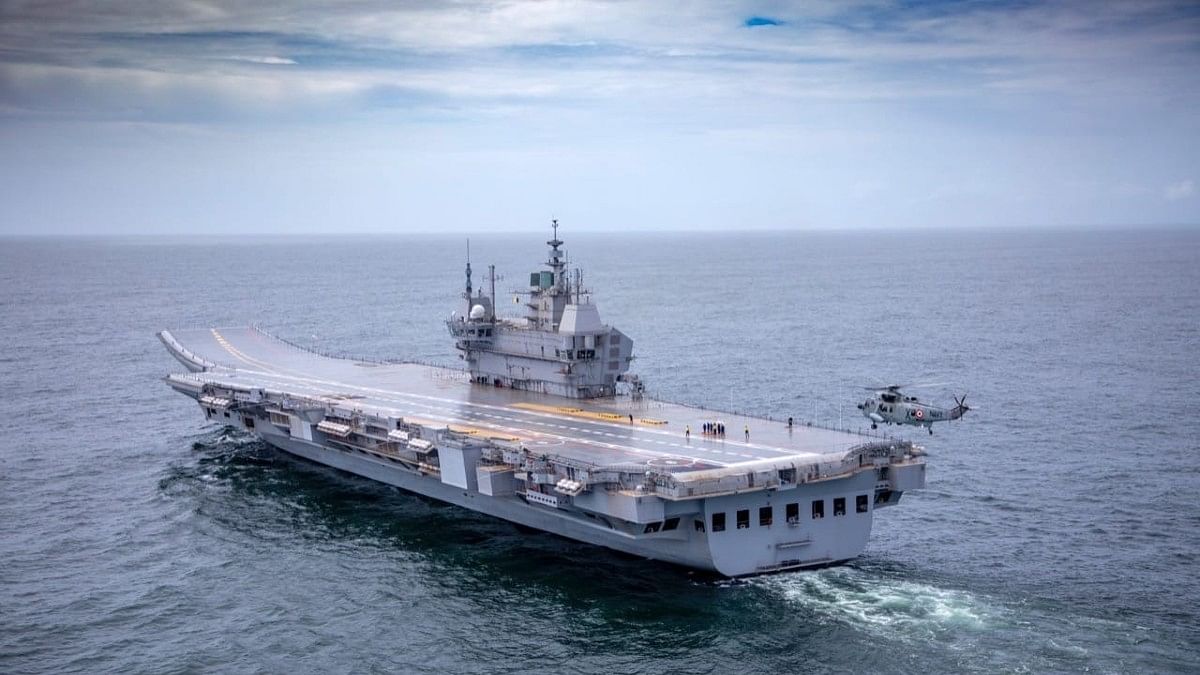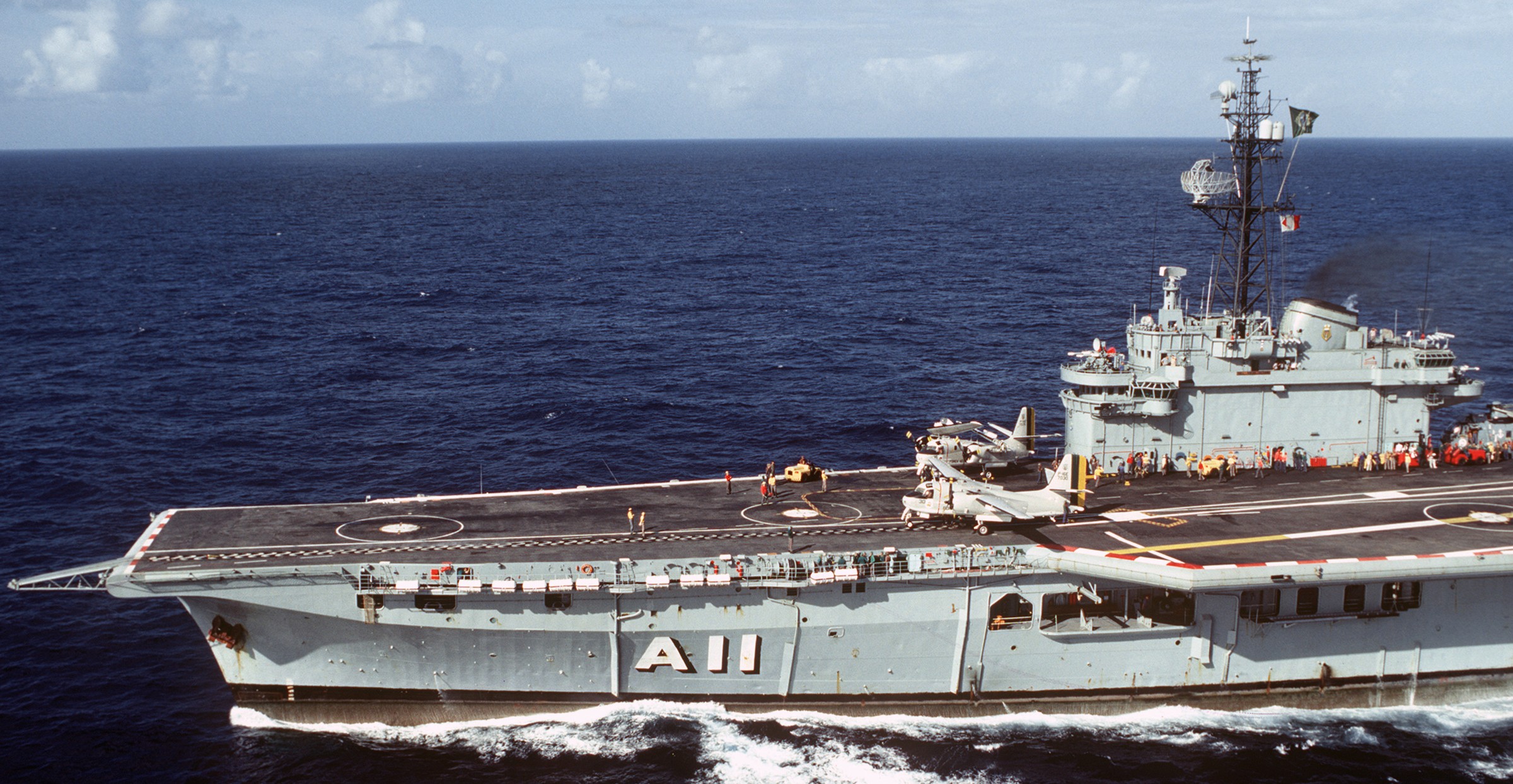Brazil Aircraft Carrier - This article requires additional references for verification. Please help improve this article by adding links to trusted sources. Non-original material may be challenged and removed. Find Sources: "Brazilian Aircraft Carrier Sao Paulo" - News Newspapers Books Scholars JSTOR (July 2012) (Learn how to delete this message template)
São Paulo (tail number A12) is a Clemceau-class aircraft carrier in service with the Brazilian Navy. São Paulo was first commissioned in 1963 by the French Navy as Foch before being transferred to Brazil in 2000 where she became the new flagship of the Brazilian Navy. IHS Jane's reported that during her career with the Brazilian Navy, São Paulo suffered from maintenance problems and was never able to operate for more than three months without the need for repairs and maintenance.
Brazil Aircraft Carrier

The aircraft carrier São Paulo was built in France between 1957 and 1960 and served in the French Navy under the name Foch. In September 2000, she was purchased from Brazil for US$30 million (price does not include aircraft) to replace the aging World War II aircraft carrier Minas Gerais, which had been in service for over 40 years. Brazil had previously approached other countries, such as Spain, who wanted to build a US$500 million air carrier for Brazil, about acquiring the air carrier.
Brazil Navy Sao Paulo Aircraft Carrier
The government has already purchased a fleet of 23 used A-4 Skyhawks in Kuwait for $70 million;
These aircraft, together with existing helicopters already in national defense service, were to form the São Paulo fighter-bomber group. These A-4s (designated AF-1) are capable of carrying weapons including rockets, free-fall bombs and Sidewinder air-to-air missiles.
The Clemceau-class aircraft carriers, the latest of which is the São Paulo, are of the conventional CATOBAR design. The flight deck is 265.5 meters (871 ft) long and 29.5 meters (97 ft) wide; the landing zone is located at an angle of 8 degrees to the axis of the ship. The front elevator of the aircraft is located on the starboard side, and the rear elevator is located on the edge of the deck to save space in the hangar. The forward section of two 52-metre (171 ft) catapults is on the port bow; the second catapult is further aft on the sloping landing deck. The hangar deck measures 152 meters (499 ft) by 22–24 meters (72–79 ft) by 7 meters (23 ft) higher.
An unusual process for such a large ship. It was accepted by the Brazilian Navy and incorporated into the Brazilian Navy on November 15, 2000. The inclusion of São Paulo and the AF-1 Fighter Group marked the fulfillment of Brazil's longstanding goal of being able to carry out air operations. defense of their ship group. forces with aircraft.
Fire Breaks Out Aboard Only Russian Aircraft Carrier, No Reports Of Injuries
The transfer of the aircraft carrier "São Paulo" to the operational sector of the navy significantly increases our naval power in terms of protecting Brazilian interests at sea. A country like ours, with a vast coastline of more than 7,000 kilometers, needs a naval power to match its position in the international arena. Today, as before, Brazil is concerned with the implementation of concrete measures that give the nation guarantees that its sovereignty will be respected. We are and always will be a nation that fights for peace, but this does not mean that we can do without modern Armed Forces, combat-ready and endowed with an adequate deterrent potential. Few countries even today have the potential to operate effectively on the high seas. It is important that Brazil continues to be one of them.”[9]
Since its construction, São Paulo has undergone many improvements, leaving behind a wide variety of technologies. The carrier arrived in Rio de Janeiro on February 17, 2001.
The number of "Sao Paulo" was 1920 people (ship company - 64 officers and 1274 sailors, another 582 people - in the air group).

During the first three years of service in São Paulo, the ship completed several missions, some in foreign waters, in particular the ARAEX operations,
North Korea Blames The Deployment Of A U.s. Aircraft Carrier For Latest Tensions
Toward the end of its service life, São Paulo served mainly to train pilots to fly aircraft carriers. It was actively used for the qualification and retraining of helicopter and aircraft pilots (about 500 ejection launches), and was also used during the first Brazilian exercises to develop carrier-based strike missions.
The explosion first killed one crew member and injured others. All the victims were taken by helicopter to the Marsilio Diaz Naval Hospital in Rio de Janeiro. Two of the injured crew members later died in hospital from their injuries. The cause of the explosion was a crack in the steam pipe. After this incident, the Navy decided to conduct an extensive inspection to repair and modernize the ship.
Front cockpit view of São Paulo in 2003. Four McDonnell Douglas AF-1 Skyhawk and Grumman S-2T Tracker fighters of the Argentine Navy are visible.
Modernization included the inspection and repair of steam turbines; Maintenance of surface condensers; Retubing of boilers; repair of two high pressure compressors; an overview of the alternator; Purchase of spare parts; maintenance of pumps, valves and structural elements; adding two API oil-water separators; installation of two water cooling units; modernization of the chemical oxidizer; repair and treatment of oil tanks; replacement of the Naval Tactical Data System, installation of a video surveillance system; installation of a transponder of the state identification system; Installation of the MAGE (ESM) system, inspection, repair and painting of the deck; modernization of the Optical Landing System processing unit; and overhaul of aircraft catapults.
A Port Quarter View Of The Brazilian Aircraft Carrier Minas Gerais (a 11), In The Harbor For Unitas Xxv, The Silver Anniversary Hemispheric Naval Exercise Involving Brazil, Chile, Colombia, Ecuador, Peru, The
The upgrade was completed in July 2009 and São Paulo was originally scheduled to be fully operational by August 2010.
Embraer also planned to upgrade twelve Brazilian Navy A-4 Skyhaws at a cost of $140 million.
The upgrade was similar to that made for the AMX and F-5EM aircraft of the Brazilian Air Force. The program included the restoration of aircraft and their control systems, as well as the introduction of new avionics, radars (in particular, the Elta 2032 radar system), energy production systems and autonomous absorption systems. Possible types of weapons that will be included in the update: MAA-1B, Python 4 and Derby AAMS.

The Brazilian Navy awarded a contract to Marsh Aviation to convert four S-2T Turbo Trackers to Airborne Early Warning (AEW) configuration and four more for refueling and delivery aboard an aircraft carrier.
Hms Ocean (l12)
Brazil was confirmed to have purchased ex-Australian and ex-Uruguayan C-1 Trader aircraft to be converted into AEW aircraft and refueling aircraft. The Brazilian Navy planned to upgrade the airframe to S-2T Turbo Tracker configuration with Honeywell TPE 331-14GR engines. The purchase included nine airframes, of which two were for AF-1 Skyhawk fuel tanker conversions and three for AEW. The rest were bought for parts or duties on goods. The requirement for the AEW radar was to have a range of 250 miles (400 km) at 25,000 feet (7,600 m). The service life of the gliders was to be 10 years. They were expected to be ready in 2011 and 2012.
São Paulo's SH-3 helicopter fleet was to be replaced by six S-70B Seahawk helicopters. They were purchased in 2008, finalized and issued for delivery. The helicopters and a set of engines and ancillary equipment were to be delivered in 2009.
Sea trials began in 2010, and since 2011 Sao Paulo has been assessed by the CIASA (Training Inspection and Advisory Commission).
São Paulo was expected to rejoin the fleet at the end of 2013, but another major fire occurred in 2012.
U.s. Navy's $13 Billion Warship Gerald R. Ford Sows Doubt It Can Defend Itself
In 2017, the Navy announced that the ship would be demobilized and decommissioned, citing the unprofitability of further repairs.
The ship, due to arrive in Aliaga, Turkey on September 7, 2022 for scrapping, was towed from Rio de Janeiro on August 4, 2022 by the Dutch tug Alp Ctre. The ship and its tugboat arrived off the Moroccan coast on August 26 and are preparing to cross the Mediterranean via Gibraltar, where the Turkish government has abruptly revoked permission for the ship to dock in Turkey.
The decision came after officials from the Turkish Ministry of the Environment found that a report submitted by the Brazilian authorities significantly underestimated the amount of hazardous materials on board a ship compared to ships of the same class and period. For example, the report estimated that just 9.6 tons of asbestos on the ship Clemceau - the sister ship of the São Paulo - contained at least 600 tons of this carcinogenic material.

Following the announcement of the decommissioning, a private foundation called Instituto São Paulo/Foch, set up by the former crew and tuzists, is also trying to turn the aircraft carrier into a museum ship, similar to the aborted plans of its predecessor Minas Gerais, and is responsible for the writ. to be towed back to Brazil is also raising concerns among several national and international environmental organizations about the potential risk of "enormous environmental damage".
Eurocopter Uh 14 Super Puma (as 332f1)
The lawyer who facilitated the return of the ship described the overall handling of the case as extremely hasty and sloppy, with the authorities bypassing a proper appraisal and selling the ship for a fraction of its real price. The Foundation was also denied an auction because the Brazilian authorities were only interested in companies seeking to dismantle the ship.
The Brazilian Navy refused to allow the ship to anchor again in Rio de Janeiro.
Lexington aircraft carrier, aircraft carrier lego set, aircraft carrier brazil, aircraft carrier, brazil aircraft, brazil navy aircraft carrier, carrier brazil, lego navy aircraft carrier, army aircraft carrier, midway aircraft carrier, aircraft carrier museum ships, aircraft carrier san diego

0 Comments